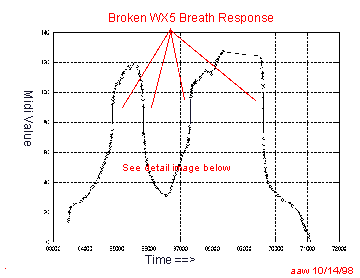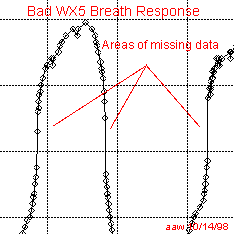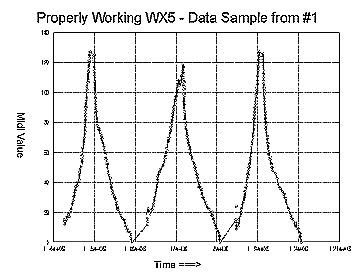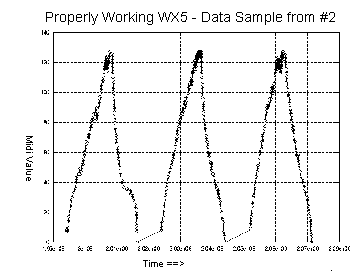WX5 Breath Curves - Working vs. Art's Broken WX5
The WX5 that I own was purchased from a European dealer on June 4, 1998, back when Yamaha first introduced this new wind controller to the world. In the early days, the controller's breath sensor worked fine, as determined by me and another musician who also played the instrument.
After several months of minimal use due to other pressing work, I started to play the WX5 for extended periods of time, trying to get used to the new feel, new reed bender performance, and new features. During this time, I was experimenting often with the breath and lip gain and offset pots, trying to tweak in the instrument's performance to match that of my WX7 and WX11.
It was during this learning phase that I started to notice an audible "jump" in the sound at around the mid-breath pressure levels. On watching the MIDI monitor on my VL1m, I noticed what looked like a significant section of missing midi breath values. Upon recording the midi data stream into my MIDI-OX computer midi monitor program, I was able to clearly see that there were missing code values between 70 and 105. See the graph below for details.

This graph is from my broken WX5, showing the "jump" in data around midi values 70-105.
During further testing, I determined that on first power-up, the "jump" in data (missing midi code values) was starting low on the breath curve (around 30), and then as the WX5 was left on, the "jumps" moved up to the original location of 70, as if the WX5 circuits were warming up. Continued data collection via my computer midi monitor confirmed the missing midi code values.
One interesting aspect of the missing code values is that since there are occasional data points within the "jumps", it would imply that the problem was analog in nature - sensor or opamp circuits. See the zoom view of the breath curve data (below).

This graph is zoomed in to closely show the "jump" in data around midi values 70-105.
After the discovery and dissapointment that my WX5 was not functioning properly, I requested other owners of WX5's to collect breath data similar to mine. This was to determine if what I was hearing was truly programmed into the breath curve, or if my WX5 was broken. As you can see from the final two graphs below, two other WX5's tested did not exhibit the problem.
So, as of 10/8/98, my WX5 is broken. The "jump" is so very audible, the WX5 is unplayable. Just ask my piano player...! I will work with Yamaha to get the WX5 repaired under warranty. I promise to provide updates as to my progress in the warranty claim.

This graph shows the typical breath response of a properly working WX5.

This graph is from a different, properly working WX5.
Yamaha Replaced WX5 Under Warranty!
I am pleased to say that Yamaha was very good about honoring the warranty on my broken WX5 (breath response was discontinuous). At the urging of my dealer, they decided to give me a brand new WX5. This one is the 0Y series, with translucent white key pins.
On very quick inspection in the dealer's showroom, the key clicking is significantly reduced, consistant with general conclusions from others on the list. Since I've now tried both, I think it's clear that white key pins quiet down the keys. Of course, we know Yamaha has admitted that white pins are subject to key binding causing the CDCDCD problem.
I'll give my new WX5 a thorough workout this weekend. I also plan to reface my spare mpc, hopefully duplicating the success of others here on the windlist.